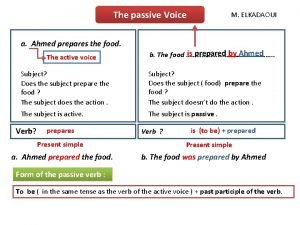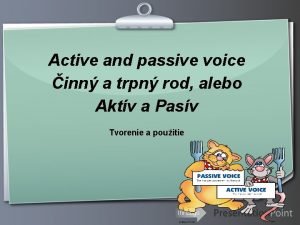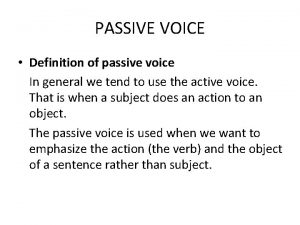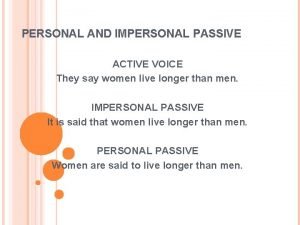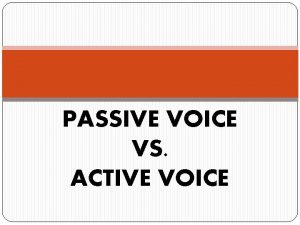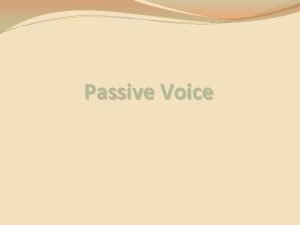The passive voice The Passive is not a







- Slides: 7

The passive voice The Passive is not a tense. You will find it easier to understand the passive if you already know the basic English verb tenses.

Present Simple Passive (1) You can have passive verbs in all the different tenses. We will start with the present simple. Here is an active verb in the present simple: Everybody loves English weather. Now let’s change it to the passive voice: English weather is loved by everybody. Toloved’ make is the passive Tosimple make use theverb passive, If you need ‘is present passive (because ‘is’ istoinmention the present rd ‘to BE’ in the same use tense the 3 as the form or who is doing the action, simple). original sentencepast – here participle it is the of the use ‘by’ to introduce it. present simple tense main verb.

Present Simple Passive (2) Take a look at some more sentences in the present simple passive. English teachers are loved by everybody. You don’t have to agree with that statement! You’re thinking ‘Some people The verb ‘to be’ is plural in don’t love English teachers!’ So let’s make that passive! this sentence to agree with ‘teachers’. English teachers are not loved by everybody. Make the verb ‘to BE’ negative in the usual way. ‘by …’ may not be necessary. If it’s not important, leave it out.

Present Continuous Passive Let’s look at how the passive works in other tenses. Here is a sentence in the present continuous: They are building a house next door. Now let’s change it to the passive voice: A house is being built next door (by them) We don’t often use To ‘to make BE’ inthe thepassive, ‘by them’ doesn’t tell us rd form or present continuous tense use the so 3 this much (who are they? ) so may look unfamiliar! past participle of the leave it out. main verb.

Past Simple Passive Here is a sentence in the past simple: Someone stole a million pounds from the bank. Now let’s change it to the passive voice: A million pounds was stolen from the bank (by someone) ‘to BE’ in the past simple To make tense theispassive, ‘by someone’ doesn’t tell ‘was’ (singular) or ‘were’ use the (plural) 3 rd form or us much (who was it? ) so past participle of the leave it out. main verb.

Present Perfect Passive Here is a sentence in the present perfect. They have forgiven you. Now let’s change it to the passive voice: You have been forgiven. ‘to BE’ in the present perfect To make the passive, tense is ‘has been’ (singular) use or the 3 rd form or ‘have been’ (plural) past participle of the main verb.

This presentation did not cover all the tenses but maybe it gave you an idea about how to form the passive. Now try some activities on other websites. Back to links to other passive voice sites




